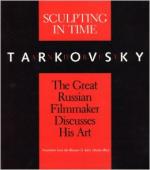|
This section contains 841 words (approx. 3 pages at 400 words per page) |

|
Rhythm Versus Editing
Tarkovsky is writing from within a fairly insular Russian filmmaking community. The film theory Tarkovsky was inundated with while a student stressed "montage cinema," the theory proposed by Russian filmmakers and theoreticians Sergei Eisenstein and Lev Kuleshov.
Eisenstein and Kuleshov believed that the chief meaning of a film is derived at the stage of editing. From the joining of two shots with disparate meanings comes a third meaning from editing, the sum being greater than its parts. This was derived from a larger Marxist and Hegelian philosophy of history: thesis and antithesis combine, and what is left is the synthesis.
Tarkovsky refutes this theory of filmmaking. He believes that rhythm is the first principle of cinema, and that rhythm is distinct from editing. The film director has his own rhythm, which he brings, like a stylistic trademark, to the film, in the form of shot selection...
|
This section contains 841 words (approx. 3 pages at 400 words per page) |

|




